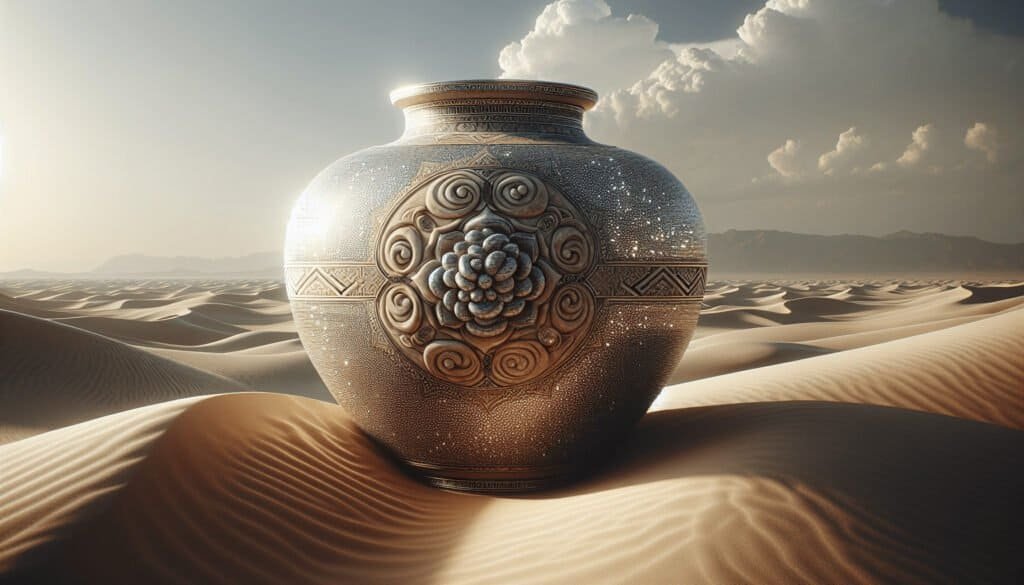Could you imagine living in a world where treasures from the past whisper secrets about purity amidst the chaos of corruption? When seeking these stories buried within the sands of time, nothing captures the imagination quite like the Desert Fortress Jars. This tale unfolds in a rich tapestry of archaeology, history, and cultural significance, beckoning you to join this quest for clarity and understanding.

The Allure of the Desert Fortress Jars
What’s so intriguing about these jars? Nestled in the stark landscapes of the desert, the Fortress Jars are more than mere artifacts; they embody stories of ancient civilizations. Each jar represents not just a container but a historical marker, filled with potential knowledge and insights waiting to be uncovered.
Historical Context: A Window to the Past
The origins of the Desert Fortress Jars can be traced back to the tumultuous times of rulers and empires striving for dominance. Archaeologically, they often emerge from sites tied to the ancient Near East, including areas that are significant for biblical narratives. These artifacts, primarily designed for storage, played a critical role in the daily lives of ancient people.
The jars come from various contexts: they might have been used to store food, oils, or precious materials. Each jar’s style, material, and form can tell you a great deal about the society that created it. From pottery classes and glaze techniques to design styles, understanding these details can give you a clearer picture of the cultural significance behind the jars.
The Purity Pursuit: Symbolism of the Jars
But why purity? In a world where corruption often corrupts ideals, these jars represent the pursuit of integrity. They were designed for preservation, often built to withstand the test of time. The symbolism behind these jars transcends their physicality—it’s about maintaining purity in contexts where purity is often compromised.
For example, many ancient religions emphasized purity in rituals and daily life. The jars, often used in ceremonial contexts, carry a message about being pristine amid chaos. They serve as a reminder that even in challenging times, there is a pursuit of cleanliness—both literally and metaphorically.
Archaeological Significance: Unearthing the Past
Discoveries and Findings
The archaeological journey to unearthing the Desert Fortress Jars has led to significant findings in various excavation sites. Each site offers new insights into the practices and lifestyles of ancient civilizations. Over the years, you can find reports filled with information about the jars’ locations, their structures, and what they contained.
Notable excavations at places like Qumran have yielded jars that played a role in the production of the Dead Sea Scrolls. These texts provide incredible insight into the cultural, religious, and historical narrative of the time. Understanding the function of these jars gives you a deeper awareness of the people who used them.
Notable Examples
| Jar Name | Location | Contents | Significance |
|---|---|---|---|
| Qumran Jars | Qumran, Israel | Dead Sea Scrolls | Religious texts preserving purity |
| Nabatean Storage Jars | Petra, Jordan | Oils and food | Daily life and trade in desert culture |
| Roman Amphorae | Various Mediterranean | Wine, oil | Insights into trade and culture |
The Historical Narrative
Examining historical records adds another layer to the discussion. Many ancient texts reference jars, detailing their use in everyday life and rituals. For instance, the Hebrew Bible describes specific preparations for purification, and jars play a critical role in these narratives.
You might recall the story of the wedding at Cana, where Jesus turned water into wine using jars designated for purification (John 2:1-11). This biblical reference illustrates the jars’ practical and theological significance, reflecting a broader cultural context.

Theological Implications: Purity in Faith
Scriptural References
Within religious texts, jars serve as symbols of spiritual purity and integrity. The discussions surrounding cleanliness and purity in various faith traditions form a fundamental part of their respective teachings. The notion of being untainted finds resonance in these artifacts, as they often relate directly to the rituals and beliefs surrounding purification.
In Christianity, for example, the theme of purification is prevalent throughout the New Testament. The idea that something as simple as a jar could represent transformation connects deeply with theological beliefs.
Ritual Significance
Consider the use of jars during rituals—it speaks volumes about the practices of ancient peoples. They weren’t just containers but key elements in worship and daily life. Using them for offerings or supplies during festivals shows how intertwined their existence was with religious life. Each pouring of oil or grain must have felt sacred, an act of connecting with the divine through something tangible.
Cultural Reflections: A Testament to Resilience
Daily Life in the Desert
The jars encapsulate daily life in arid environments. Their design reflects an understanding of climate and necessity—how best to store food and water. In many ways, these artifacts showcase human ingenuity, adapting materials available in nature to serve vital functions efficiently.
By dissecting the civilization around the jars, you can glean insights into how people thrived against the odds, emphasizing their resilience. As you consider their culture, think about how they cultivated a community despite environmental challenges.
Trade and Economy
The jars also resonate with economic implications. They were not merely containers; they played a significant role in trade networks thriving across ancient routes. Craftsmanship varied from region to region, each carving a unique identity into the jars they produced.
How people interacted while exchanging goods paints a picture of social structures and economic relationships. The presence of jars at various trade posts signals the importance of these artifacts in day-to-day commerce and cultural exchange.
Modern Perspectives: Connecting Ancient to Contemporary
Lessons from the Past
As you ponder the relevance of the Desert Fortress Jars, think about what lessons emerge. In a contemporary world filled with complexities, the quest for purity remains vital. Just like ancient civilizations sought to maintain clarity and cleanliness, you too might feel the desire to hold onto these ideals.
The jars serve as reminders that despite chaos and corruption, there’s a yearning for integrity. Perhaps their stories can inspire you to pursue authenticity, whether in your personal life, community, or faith.
Cultural Heritage and Preservation
Additionally, these jars are essential in discussions about cultural heritage. As you engage with the efforts taken to preserve and protect archaeological findings, it brings forth questions regarding ownership and stewardship of history. How societies choose to maintain these artifacts reflects their values and aspirations.
The responsibility of recognizing and preserving such cultural treasures lies heavily on the shoulders of current generations. It’s about creating a legacy that honors the past while paving the way for the future.
Conclusion: A Journey Worth Taking
In drawing this narrative to a close, reflect on the Apache saying, “We do not inherit the earth from our ancestors; we borrow it from our children.” The stories held within the Desert Fortress Jars go beyond ancient history; they present an opportunity for growth and understanding in a world that desperately needs reminders of purity and resilience.
As you continue your quest for knowledge, consider how these artifacts inform your understanding of the past, revealing cultural, economic, and spiritual significances that still resonate today. Whether you are an academic, a curious mind, or a seeker of truth, the journey of the Desert Fortress Jars invites you to reflect, question, and, ultimately, retain the lessons from what was once lost to time.



